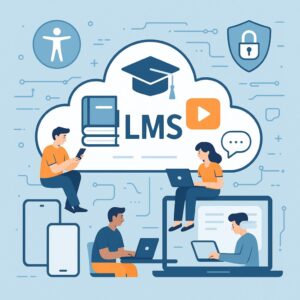As institutions and businesses look for new approaches to delivering learning content, they quickly find themselves in an ever-evolving education environment. The best solution is to use a cloud-based Learning Management System (LMS), which can help you save time and money. This method is changing how learners access the material, and it offers many advantages to improve the learning process.
Accessibility and Flexibility
One of the key benefits of an LMS cloud-based solution is its flexibility. The platform is accessible from anywhere, anytime, with internet connectivity. On-demand learning is great for different types of learners, as it allows them to focus on content when it best fits their schedule. Students can study from anywhere, be it at home, in a library, or on the go.
This ease of access is also beneficial for educators. Users can modify resources, assess tasks, and interact with learners anywhere. Such convenience ultimately enables a more vibrant and responsive learning ecosystem.
Cost-Effectiveness
For institutions and businesses, finances matter. Cloud-based LMS does away with heavy capital investments in hardware and software. Instead, organizations pay for what they use on an as-needed basis, typically on a subscription basis. It mitigates high upfront costs while enabling customizable financial planning.
This is a kind of software that is maintained and updated by the service provider; this allows institutions to save money on real, physical servers and dedicated IT staff. This would allow resource allocation into bettering the education content and other key areas.
Scalability
Most educational institutions and businesses grow and expand. Scaling becomes a non-issue with a cloud-based LMS solution since it allows for an unlimited number of users and more content to be added without any degradation in performance. The system can scale without affecting the throughput as the number of learners increases.
Scalability can be extended to features and functionality, too. As the organization’s needs change, new tools and integrations can be added, ensuring that the platform is relevant and effective. This flexibility allows a cloud-based LMS to be used for an extended period of time.
Security and Reliability
Data security is a top concern in any digital solution. Providers of Cloud-based LMSA are keen on safeguarding sensitive data. They utilize strong security protocols like encryption and multi-factor authentication to protect user data.
These platforms are also very reliable. Service providers ensure their systems have minimal downtime, which means that learners can access any material as and when needed. The reliability of the system is further enhanced through regular backups and disaster recovery plans.
User-Friendly Interface
An intuitive interface is a must for any educational tool. A user-oriented approach to LMS in the cloud. The best LMS has simple navigation and clear directions, which accommodate both instructors and learners.
Customization options exist, where organizations can adjust the platform according to their needs. Let’s immerse ourselves in learning, which creates a sense of familiarity and warmth, eventually leading to enhanced satisfaction and results.
Teamwork and Communication
Learning cannot thrive without communication and collaboration. A cloud-based LMS enables interaction through discussion forums, chat features, and video conferencing, among other tools. Such tools allow learners to reach out to fellow students and instructors, thereby increasing the sense of community.
Collaboration features support group projects and peer assessments. Even if learners live in different parts of the world, they can collaborate in real time, which promotes collaboration and enriches the learning process.
Continuous Improvement and Innovation
The educational sector has never been constant, and cloud-based LMS providers are always keeping pace with it. They constantly provide updates and new features with their benefits. This commitment means that users never miss out on next-generation advancements in edtech.
Also, providers will usually invite their users to send their suggestions or ideas to improve future iterations. They present solutions that meet actual challenges by listening to the real needs of educators and learners. With regular updates, this emphasis on continuous improvement keeps cloud-based LMS platforms relevant and effective over time.
Conclusion
There are very few cloud-based LMS types that help improve how you teach and learn, but they provide plenty of benefits nonetheless. Their flexibility, cost-effectiveness, scalability, and security make them an attractive option for institutions and enterprises. These platforms offer a complete solution for smart education with easy-to-use interfaces and collaborative tools. In a constantly evolving academic climate, the cloud-based LMS serves as a quick and dependable solution for the future.




